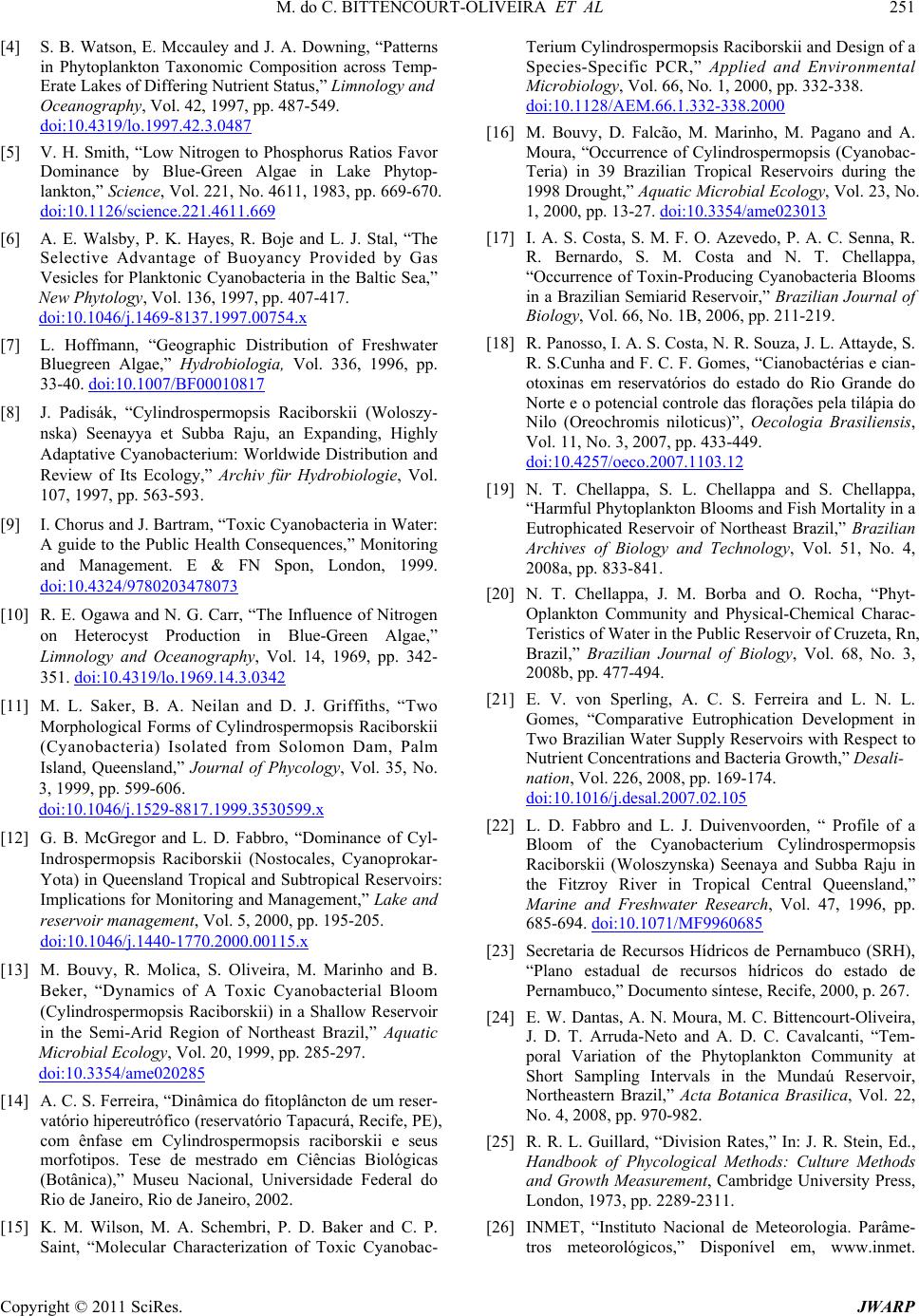
M. do C. BITTENCOURT-OLIVEIRA ET AL 251
[4] S. B. Watson, E. Mccauley and J. A. Downing, “Patterns
in Phytoplankton Taxonomic Composition across Temp-
Erate Lakes of Differing Nutrient Status,” Limnology and
Oceanography, Vol. 42, 1997, pp. 487-549.
doi:10.4319/lo.1997.42.3.0487
[5] V. H. Smith, “Low Nitrogen to Phosphorus Ratios Favor
Dominance by Blue-Green Algae in Lake Phytop-
lankton,” Science, Vol. 221, No. 4611, 1983, pp. 669-670.
doi:10.1126/science.221.4611.669
[6] A. E. Walsby, P. K. Hayes, R. Boje and L. J. Stal, “The
Selective Advantage of Buoyancy Provided by Gas
Vesicles for Planktonic Cyanobacteria in the Baltic Sea,”
New Phytology, Vol. 136, 1997, pp. 407-417.
doi:10.1046/j.1469-8137.1997.00754.x
[7] L. Hoffmann, “Geographic Distribution of Freshwater
Bluegreen Algae,” Hydrobiologia, Vol. 336, 1996, pp.
33-40. doi:10.1007/BF00010817
[8] J. Padisák, “Cylindrospermopsis Raciborskii (Woloszy-
nska) Seenayya et Subba Raju, an Expanding, Highly
Adaptative Cyanobacterium: Worldwide Distribution and
Review of Its Ecology,” Archiv für Hydrobiologie, Vol.
107, 1997, pp. 563-593.
[9] I. Chorus and J. Bartram, “Toxic Cyanobacteria in Water:
A guide to the Public Health Consequences,” Monitoring
and Management. E & FN Spon, London, 1999.
doi:10.4324/9780203478073
[10] R. E. Ogawa and N. G. Carr, “The Influence of Nitrogen
on Heterocyst Production in Blue-Green Algae,”
Limnology and Oceanography, Vol. 14, 1969, pp. 342-
351. doi:10.4319/lo.1969.14.3.0342
[11] M. L. Saker, B. A. Neilan and D. J. Griffiths, “Two
Morphological Forms of Cylindrospermopsis Raciborskii
(Cyanobacteria) Isolated from Solomon Dam, Palm
Island, Queensland,” Journal of Phycology, Vol. 35, No.
3, 1999, pp. 599-606.
doi:10.1046/j.1529-8817.1999.3530599.x
[12] G. B. McGregor and L. D. Fabbro, “Dominance of Cyl-
Indrospermopsis Raciborskii (Nostocales, Cyanoprokar-
Yota) in Queensland Tropical and Subtropical Reservoirs:
Implications for Monitoring and Management,” Lake and
reservoir management, Vol. 5, 2000, pp. 195-205.
doi:10.1046/j.1440-1770.2000.00115.x
[13] M. Bouvy, R. Molica, S. Oliveira, M. Marinho and B.
Beker, “Dynamics of A Toxic Cyanobacterial Bloom
(Cylindrospermopsis Raciborskii) in a Shallow Reservoir
in the Semi-Arid Region of Northeast Brazil,” Aquatic
Microbial Ecology, Vol. 20, 1999, pp. 285-297.
doi:10.3354/ame020285
[14] A. C. S. Ferreira, “Dinâmica do fitoplâncton de um reser-
vatório hipereutrófico (reservatório Tapacurá, Recife, PE),
com ênfase em Cylindrospermopsis raciborskii e seus
morfotipos. Tese de mestrado em Ciências Biológicas
(Botânica),” Museu Nacional, Universidade Federal do
Rio de Janeiro, Rio de Janeiro, 2002.
[15] K. M. Wilson, M. A. Schembri, P. D. Baker and C. P.
Saint, “Molecular Characterization of Toxic Cyanobac-
Terium Cylindrospermopsis Raciborskii and Design of a
Species-Specific PCR,” Applied and Environmental
Microbiology, Vol. 66, No. 1, 2000, pp. 332-338.
doi:10.1128/AEM.66.1.332-338.2000
[16] M. Bouvy, D. Falcão, M. Marinho, M. Pagano and A.
Moura, “Occurrence of Cylindrospermopsis (Cyanobac-
Teria) in 39 Brazilian Tropical Reservoirs during the
1998 Drought,” Aquatic Microbial Ecology, Vol. 23, No.
1, 2000, pp. 13-27. doi:10.3354/ame023013
[17] I. A. S. Costa, S. M. F. O. Azevedo, P. A. C. Senna, R.
R. Bernardo, S. M. Costa and N. T. Chellappa,
“Occurrence of Toxin-Producing Cyanobacteria Blooms
in a Brazilian Semiarid Reservoir,” Brazilian Journal of
Biology, Vol. 66, No. 1B, 2006, pp. 211-219.
[18] R. Panosso, I. A. S. Costa, N. R. Souza, J. L. Attayde, S.
R. S.Cunha and F. C. F. Gomes, “Cianobactérias e cian-
otoxinas em reservatórios do estado do Rio Grande do
Norte e o potencial controle das florações pela tilápia do
Nilo (Oreochromis niloticus)”, Oecologia Brasiliensis,
Vol. 11, No. 3, 2007, pp. 433-449.
doi:10.4257/oeco.2007.1103.12
[19] N. T. Chellappa, S. L. Chellappa and S. Chellappa,
“Harmful Phytoplankton Blooms and Fish Mortality in a
Eutrophicated Reservoir of Northeast Brazil,” Brazilian
Archives of Biology and Technology, Vol. 51, No. 4,
2008a, pp. 833-841.
[20] N. T. Chellappa, J. M. Borba and O. Rocha, “Phyt-
Oplankton Community and Physical-Chemical Charac-
Teristics of Water in the Public Reservoir of Cruzeta, Rn,
Brazil,” Brazilian Journal of Biology, Vol. 68, No. 3,
2008b, pp. 477-494.
[21] E. V. von Sperling, A. C. S. Ferreira and L. N. L.
Gomes, “Comparative Eutrophication Development in
Two Brazilian Water Supply Reservoirs with Respect to
Nutrient Concentrations and Bacteria Growth,” Desali-
nation, Vol. 226, 2008, pp. 169-174.
doi:10.1016/j.desal.2007.02.105
[22] L. D. Fabbro and L. J. Duivenvoorden, “ Profile of a
Bloom of the Cyanobacterium Cylindrospermopsis
Raciborskii (Woloszynska) Seenaya and Subba Raju in
the Fitzroy River in Tropical Central Queensland,”
Marine and Freshwater Research, Vol. 47, 1996, pp.
685-694. doi:10.1071/MF9960685
[23] Secretaria de Recursos Hídricos de Pernambuco (SRH),
“Plano estadual de recursos hídricos do estado de
Pernambuco,” Documento síntese, Recife, 2000, p. 267.
[24] E. W. Dantas, A. N. Moura, M. C. Bittencourt-Oliveira,
J. D. T. Arruda-Neto and A. D. C. Cavalcanti, “Tem-
poral Variation of the Phytoplankton Community at
Short Sampling Intervals in the Mundaú Reservoir,
Northeastern Brazil,” Acta Botanica Brasilica, Vol. 22,
No. 4, 2008, pp. 970-982.
[25] R. R. L. Guillard, “Division Rates,” In: J. R. Stein, Ed.,
Handbook of Phycological Methods: Culture Methods
and Growth Measurement, Cambridge University Press,
London, 1973, pp. 2289-2311.
[26] INMET, “Instituto Nacional de Meteorologia. Parâme-
tros meteorológicos,” Disponível em, www.inmet.
Copyright © 2011 SciRes. JWARP